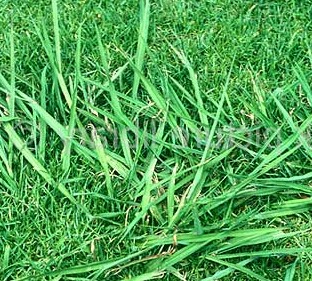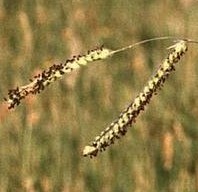 Dallisrass, also called sticky heads, is a coarse textured, tufted, perennial grass native to Brazil and Argentina where it grows in moist disturbed sites such as pastures, lawns, and golf courses. It has been introduced into the US and now is found in the southern half of the US from coast to coast north into California and Oregon. Spreading by rhizomes it grows rapidly forming a wide ,dense, stiff mat over three feet wide. In addition, it self-seeds readily and can be invasive . It is considered a noxious weed in some places and listed as one of the ten worst weeds of crops. The generic name, Paspalum, is from the Greek word paspalos meaning millet. The specific epithet, dilatatum, is from the spine of the Latin verb differo meaning spread out.
Dallisrass, also called sticky heads, is a coarse textured, tufted, perennial grass native to Brazil and Argentina where it grows in moist disturbed sites such as pastures, lawns, and golf courses. It has been introduced into the US and now is found in the southern half of the US from coast to coast north into California and Oregon. Spreading by rhizomes it grows rapidly forming a wide ,dense, stiff mat over three feet wide. In addition, it self-seeds readily and can be invasive . It is considered a noxious weed in some places and listed as one of the ten worst weeds of crops. The generic name, Paspalum, is from the Greek word paspalos meaning millet. The specific epithet, dilatatum, is from the spine of the Latin verb differo meaning spread out.
Descripton:
 Short rhizomes with thick fibrous roots extending up to a yard in depth produce basal foliage and a cluster of smooth green shoots tinged with purple sixteen to sixty nine inches long. The coarse dull to dark green leaves are .12-.6 inches wide wide by 2.4-24 inches long and have a prominent mid vein and a few long hairs near their base. The leaf edges are wavy and roughened and the tips pointed. The ascending to erect flower-bearing stems (culms) are usually unbranched and carry terminal panicles of three to five one-sided racemes each 1-4.3 inches long and bearing three to four rows of paired, purplish-green, hairy spiklets .
Short rhizomes with thick fibrous roots extending up to a yard in depth produce basal foliage and a cluster of smooth green shoots tinged with purple sixteen to sixty nine inches long. The coarse dull to dark green leaves are .12-.6 inches wide wide by 2.4-24 inches long and have a prominent mid vein and a few long hairs near their base. The leaf edges are wavy and roughened and the tips pointed. The ascending to erect flower-bearing stems (culms) are usually unbranched and carry terminal panicles of three to five one-sided racemes each 1-4.3 inches long and bearing three to four rows of paired, purplish-green, hairy spiklets .
Control:
A perennial growth habit and deep root system make this weed difficult to dig out but early infestations may be eliminated in this way. Cut a circle in the soil around the plant and then use a deep tool to reach downward and get out as much of the root as possible. Maintenance of a good turf will discourage the establishment of dallasgrass and is an important step in maintaining its control. Since dallisgrass produces up to 250,000 seed per plant a preemergent herbicide may be useful to discourage germination.